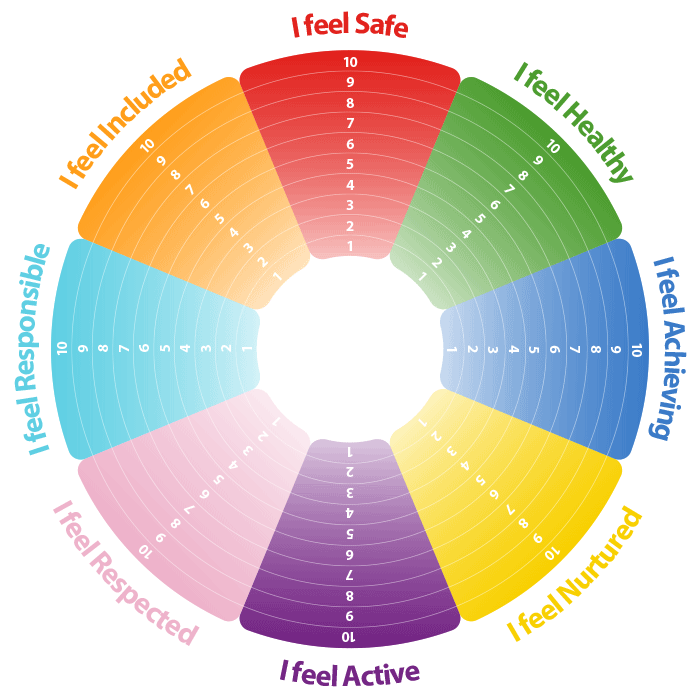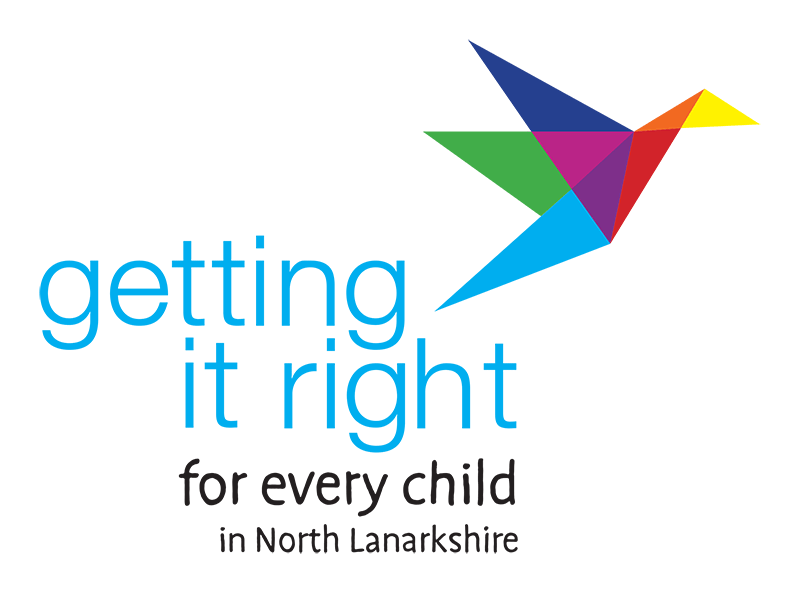Parents and Carers
What does GIRFEC mean for me?
The main aim of GIRFEC is to improve outcomes for all children and young people.
GIRFEC uses 8 words to describe what it looks like when things are going well for children and young people. These 8 words are called the wellbeing indicators (sometimes referred to as Shanarri).
As a parent or carer of a child you are the best person to ensure that your child’s wellbeing is the best it can be. What we mean by wellbeing is that your child will be safe, healthy, achieving, nurtured, active, respected, responsible and included. Most parents and carers usually have family and friends around them to support them to do this.
There may be times however, when you need additional help to develop your child’s wellbeing and children, young people and families need to know who they can contact when they need access to relevant support. Health professionals (Health Visitor, G.P., Dentist, Speech and Language Therapist, etc.) and education staff (early years staff, and teachers) are there if you need any help, at any time. They will work with you, to support your child’s wellbeing or pass you onto the right person who will help you.
The GIRFEC approach ensures every child or young person will have a designated Named Person available to them. This is an identified professional whose job it is to be a first point of contact for you, your child or anyone who has a concern about your child or young person’s wellbeing.
Your child or young person’s Named Person will be available to provide information, support or advice, or can help you to access, or signpost you to, appropriate services when needed.
The support of a Named Person is available to all children, young people and their families. There is no obligation on children, young people and families to accept the offer of advice or support from a Named Person.
Local arrangements and the term used to describe this role may vary from area to area but in North Lanarkshire we continue to use the term Named Person.
What is wellbeing?
To read more open our Parent information leaflet.
The United Nations Convention on the Rights of the Child (UNCRC) is fully embedded within the values and principles of the GIRFEC approach promoting the wellbeing of all children and young people.
The GIRFEC definition of wellbeing is drawn from eight key areas that contribute to children’s optimal development. These eight indicators of wellbeing, safe, healthy, achieving, nurtured, active, respected, responsible and included are often referred to as Shanarri.
It is the aspiration of North Lanarkshire Council that your children and young people will be safe, healthy, achieving, nurtured, active, respected, responsible and included so that they can grow to be successful learners, confident individuals, effective contributors and responsible citizens.
Some of the main tools used to help children and young people think about and understand their own wellbeing and the wellbeing of others are:
Wellbeing wheel
Children and young people are familiar with the indictors of wellbeing and are using the wellbeing wheel in discussions about wellbeing.
Click on a Wellbeing indicator to find out more.
Wellbeing web
Children and young people can use the wellbeing from 1 to 10. (1 = not so good, 10 = brilliant) The wellbeing web can be revisited over time to check on any changes to wellbeing

What I think tool
When your child or young person is in school, their Named Person or someone who knows them very well might talk with them about their wellbeing, they might use the ‘What I think Tool’. This helps your child or young person to write down what they think about the help they receive with their wellbeing and any difficulties they might be having so that they can get the right help from the right people quickly, whenever they need it.
Sid and Shanarri
Sid and Shanarri is a storybook and game resource designed for use with pre-school children. It is used in all our nursery provisions to help young children understand what is meant by wellbeing.
You can learn more at the website SidandShanarri.co.uk.
What happens if my child or young person needs help with their wellbeing?
Named Person
Before your child enrols in primary 1, your child’s Named Person will be your Health Visitor or Family Nurse Practitioner. Health has the responsibility until your child starts school. Once your child has started primary school your Named Person is usually your child’s Head or Depute Head teacher. When your child moves onto secondary school their Named Person is usually their Pastoral Support Teacher.
Their role is to promote, support and safeguard the wellbeing of children.
They are your point of contact if you need any advice, have concerns about your child’s wellbeing or require help for your child. They will listen to you and take the appropriate action required to support the wellbeing of your child. This may involve consulting with others who may become part of the team around your child supporting assessment and planning.
Your concerns might be about how you child is coping with homework, illness, social media, bullying, behavioural issues, their emotional wellbeing, changes in the family or something else.
If you do not know who your child or young person’s Named Person is ask at their school office, staff there will be able to find for out you, or if they are under five speak to someone in your GP surgery.
Getting it right for every child – Practice Guidance 2 – Role of the named person – 2022
Nursery
Primary
Secondary
Assessment and Planning
All staff working with your child use the wellbeing indicators as a framework to assess wellbeing so that any areas of need as well as areas of strengths can be identified. This allows staff to identify any supports that might be needed to enable planning for your child to begin. The Named Person may need to bring in additional help or support to enable the plan to be effective for your child. You and your child will always be involved.
In nurseries and schools we begin planning for your child as soon as needs are identified that require an action. The Getting it right for me plan (Girfme plan) allows staff to record strategies, resources, interventions from the earliest point to prevent difficulties escalating. If your child need specific learning objectives to support their wellbeing these can also be recorded in their Girfme plan. You and your child will be involved in the Girfme plan and will be asked for your comments and ideas to support the plan.
Health visitors use their Wellbeing plan when actions are required to improve the wellbeing of a pre-school child.
Tools used by staff to assess wellbeing.
These tools allow staff to assess children’s strengths and difficulties against the eight indicators of wellbeing. By including assessment of a child’s strengths, staff can build on these to help improve any areas of need.
The My World assessment triangle considers the whole child in context –‘My wider world’, ‘How I grow and develop’ and ‘What I need from people who look after me’
Where more intensive support for your child needs to be planned for, usually when a number of agencies are involved in supporting your child’s wellbeing then a Child’s Plan may be developed. The plan will tell you what actions need to be taken and who will help with each action. It will usually be someone called a ‘Lead Professional’ who will have the job of making sure that the actions outlined in the plan take place and things get better for your child.
Lead Professional
In some circumstances there may be two or more agencies working together to improve outcomes for your child or young person. The team around your child will consider the level of planning for them and if a Child’s Plan is deemed appropriate, a Lead Professional will be identified to manage your Child’s Plan.
The Lead Professional will:
- make sure you and your child understand what is happening so that you can both be involved in the decisions that affect your child
- co-ordinate the plan and check whether all the things that people said they would do are being done
- ensure the information in your child’s plan is accurate and up-to-date and is being shared with you and all the people involved in helping your child
- ensure that the plan is regularly reviewed to make sure it is continuing to support your child’s needs.
When a child is on the Child Protection register or is experiencing care the Lead Professional will always be your child’s social worker.
Getting it right for every child – Practice Guidance 3 – Role of the lead professional – 2022
Sharing Information
GIRFEC is about making sure children, young people and their families get the help they need, when they need it. So when staff from different agencies are working together to support planning for your child or young person, they may need to share relevant information. Staff will discuss with you before sharing any information about you or your child, unless there is a risk to your child, usually in child protection cases.
The adult wishing to share your child’s information, usually their Named Person, will explain what information is to be shared, with whom and why the information is being shared and what hopes to be achieved by sharing the information?
Getting it right for every child – Information Sharing Charter – Parents and Carers – 2022
All staff from all agencies follow the guidelines produced by the Lanarkshire Data Sharing Partnership Board when sharing information.


